- Home
- »
- Healthcare IT
- »
-
Telehealth Market Size And Share Analysis Report, 2030GVR Report cover
![Telehealth Market Size, Share & Trends Report]()
Telehealth Market Size, Share & Trends Analysis Report By Product Type (Hardware, Software, Services), By Delivery Mode (On-Premise, Web-based), By End-use, By Disease Area, By Region, And Segment Forecasts, 2024 - 2030
- Report ID: GVR-4-68039-909-7
- Number of Report Pages: 130
- Format: PDF, Horizon Databook
- Historical Range: 2018 - 2022
- Forecast Period: 2024 - 2030
- Industry: Healthcare
Telehealth Market Size & Trends
The global telehealth market size was estimated at USD 101.2 billion in 2023 and is projected to grow at a compound annual growth rate (CAGR) of 24.3% from 2024 to 2030. The market growth is being driven by growing demand for remote healthcare services, especially due to COVID-19 pandemic, where need for virtual consultations and remote monitoring surged.
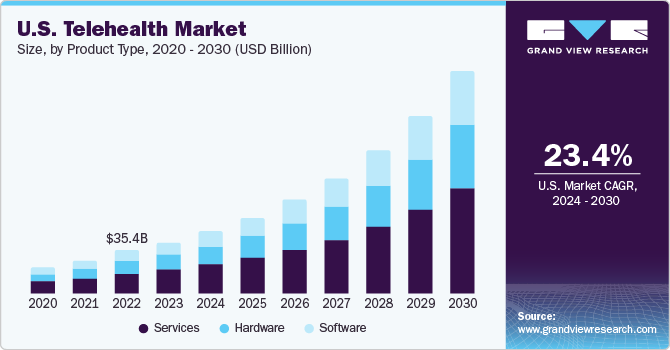
In addition, advancements in technology, including improved internet connectivity and adoption of smartphones, contribute to expansion of telehealth by making healthcare services more accessible and convenient for patients. The emphasis on cost-effective and efficient healthcare solutions further propels the adoption of telehealth, driving market growth.
Market Concentration & Characteristics
The market is characterized by a high degree of innovation, with the introduction of new technologies and methods. Technologies like deep learning, machine learning, and AI functionalities play a crucial role in enhancing the personalization of healthcare services. In telehealth, AI and machine learning are integrated to aid in the conclusive analysis of patients remotely.
Several market players such as GE Healthcare, Cerner Corporation (Oracle), Siemens Healthineers, Medtronic, are involved in merger and acquisition activities. Through M&A activity, these companies can expand their geographic reach and enter new territories.
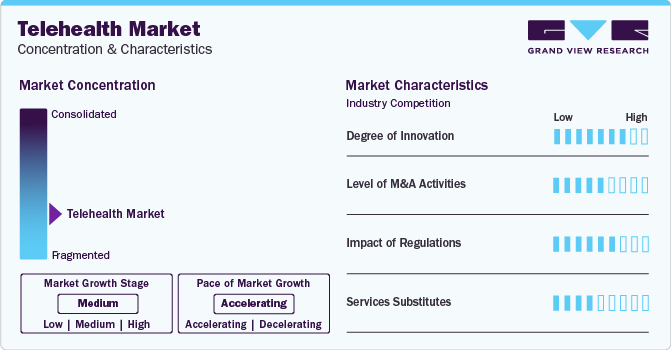
Regulations, particularly the Health Insurance Portability and Accountability Act (HIPAA) of 1996 and its amendments under Health Information Technology for Economic and Clinical Health (HITECH) Act, have a significant impact on market. These regulations play a crucial role in ensuring the secure handling and privacy of digital health information, shaping the operational framework and compliance standards for telehealth services especially in U.S.
The market has various products that are similar and are available at prices ranging from low to high, depending on the services being used. Although patients can visit hospitals and clinics for diagnosis and treatment, service providers in market have found ways to commercialize their products and thrive in this highly competitive market. Most of the telehealth service providers offer almost similar services for patient treatment and care.
Market Dynamics
Furthermore, integrating artificial intelligence and machine learning algorithms enhances personalization of healthcare services. For instance, Halodoc’s telehealth platform integrated with AI enables physicians to receive patient feedback on consultations and access training programs for performance improvement. In addition, governmental initiatives aimed at promoting telehealth adoption are driving the market growth. For instance, initiatives such as the National Digital Health Mission (NDHM) are expected to increase preference and adoption of the e-healthcare model in India. Similarly, the “Innovation Strategy 2019-2021” implemented in UAE drives digital transformation in the healthcare sector. Federal communications in the U.S. established several programs in March 2020 to help healthcare organizations deploy telemedicine technology.
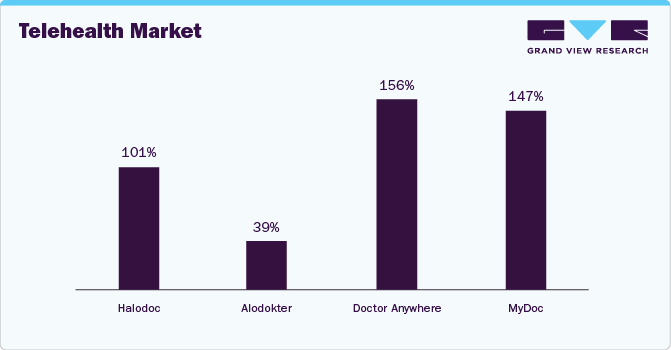
Global adoption of telehealth services is propelled by increasing funding and government initiatives. For instance, in August 2021, U.S. Administration announced an investment of approximately 19 million to improve healthcare delivery and address gaps in care faced in rural areas with poor access to critical services. Moreover, key players have been focusing on strategies, collaborations, mergers & acquisitions to gain a competitive edge and expand their product portfolio and business footprint. For instance, in June 2022, Oracle acquired a 69.2% stake in Cerner Corporation. Post this acquisition, both companies will develop advanced healthcare analytics solutions and expand their product portfolio & business footprint. This acquisition will enhance patient outcomes, promote patient involvement, and save healthcare costs by leveraging cloud capabilities by making information more secure.
Moreover, increasing prevalence of cancer globally is expected to be a key contributor to growth of market. This growing prevalence is expected to put pressure on healthcare systems, many of which are experiencing a shortage of healthcare professionals, including doctors and nurses. This is projected to stimulate the global adoption of these services. WHO predicts that healthcare facilities will face a 15 million healthcare professionals’ shortage by 2030. This scarcity of healthcare professionals is anticipated to fuel adoption of AI for patient treatment and diagnosis. Telehealth helps to deliver healthcare services digitally and virtually to patients at remote locations.
This technology enables the delivery of patient-centric care to individuals remotely, reducing the need for emergency department visits and lowering the hospitalization rate.
Product Type Insights
Services segment held the largest revenue share of 47.2% in 2023. The segment is anticipated to grow at a lucrative rate owing to prevailing trend of outsourcing these services. As healthcare facilities lack resources and skill sets required for deployment of digital health solutions, these services are outsourced. Growing need of telehealth application in chronic disease management, real-time monitoring, rapid advancements in digital infrastructure, growing internet & smartphone penetration, development in hardware & software components is driving segment growth. As a result, constantly evolving digital space is expected to support growing need for these services.
Software segment is anticipated to witness the fastest CAGR of 24.8% over the forecast period. High demand for reducing rapidly rising medical costs, growing need for accurate & timely information procurement, and rising patient care costs are among key factors responsible for segment growth. In addition, owing to government reforms and a rise in demand for technologically advanced Healthcare IT solutions, this segment is expected to launch various new products and improved versions of existing software. For instance, in June 2022, GoMeyra launched a telehealth platform, GoVirtual Clinic, a unified cloud-based solution providing a single interface for physicians, nurses, and laboratories to conduct medical tests and engage in secure remote consultations with patients.
Delivery Mode Insights
Based on delivery mode, web-based delivery mode held the largest share in 2023, owing to rise of virtual care & web-based applications and an increasing adoption of web-based delivery methods that provide patients with direct access to healthcare services. Web-based solutions are delivered to users through web servers using internet protocol. Web-based solutions comprise four aspects, including internet connection, data administrator, web server, and software coding system. Utilizing internet and web-based services provides access to most remote areas using only one computer or monitoring device.
Cloud-based delivery segment is anticipated to witness the fastest CAGR over the forecast period owing to rising adoption of cloud-based applications by both healthcare providers and patients, along with introduction of technologically advanced solutions. Moreover, seamless data storage & recovery, high bandwidth, enhanced security, easy accessibility provided by cloud-based applications are further contributing to the growth of the segment. Cloud-based solutions enable patient monitoring and teleconsultation for individuals, which require immediate medical assistance in rural and remote locations.
Disease Area Insights
In 2023, radiology segment emerged as the largest segment, owing to rising prevalence of target diseases, such as cancer, cardiovascular diseases, chronic obstructive pulmonary disease (COPD), etc., growing shortage of radiologists, and increasing demand for remote medical imaging is boosting adoption of telehealth services for radiology. COVID-19 has also emphasized importance of teleradiology. Furthermore, integration of AI into teleradiology, implementation of Picture Archiving and Communication System (PACS), and growing R&D activities pertaining to eHealth are a few additional factors expected to boost demand for teleradiology services during the forecast period. For instance, 5C Network, an Indian teleradiology provider, introduced Prodigi, an AI-driven platform that utilizes advanced technology to guarantee that no radiology image remains unreported for more than 2–3 hours.
Psychiatry segment is anticipated to grow at the fastest rate over the forecast period from 2024 to 2030, owing to increase in patient pool of anxiety, stress, and mental illnesses. Several people are adopting services to treat mental health. Also, the eased regulations for telehealth have expanded the access to virtual visits for therapy and other mental health services. In addition, the shortage of psychiatry beds further increases the need for virtual consultation services, thereby boosting segment growth.
End-use Insights
Provider segment held the largest share in 2023 due to increasing adoption of teleconsultation, telemedicine, and telehealth among healthcare professionals to reduce burden on healthcare facilities. Moreover, increased convenience offered by these solutions for quick and seamless access to real-time quality reporting, patient health records, improved decision-making, improved data management, and eHealth solutions is expected to increase adoption of these services among the providers. Many healthcare facilities have witnessed considerable improvement in workflow management through adopting these services, which is boosting its adoption.
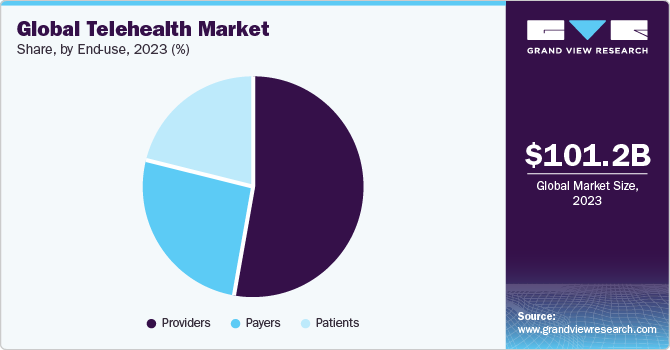
The payers segment is anticipated to witness fastest CAGR over the forecast period. Payers comprise insurance companies, health plan sponsors (employers and unions), and third-party payers. The payer industry has witnessed a rapid increase in telehealth claims due to the COVID-19 pandemic and providers are adopting telehealth for all in-person and non-urgent care. Payers are turning toward telehealth to provide its members with the right care at the right time in the right place while also saving the member and the employer money owing to major cost-saving opportunities offered by telehealth services, including lower cost per visit in comparison with in-person visits and fewer diagnostics associated with telehealth visits than with in-person visits.
Regional Insights
North America dominated the market in 2023 with the largest revenue share of 46.3%. This dominance is attributed to the region's higher healthcare IT expenditure and extensive penetration of internet and smartphone users. North America stands out as one of the earliest adopters of smart healthcare solutions, incorporating technologies such as smart wearables, eHealth services such as HERS telemedicine, and mobile apps. These solutions enable remote access to information on severe and chronic healthcare conditions. Key factors propelling the growth of telehealth services in North America include the rapid adoption of smartphones, advancements in coverage networks, significant shortage of primary caregivers, surge in chronic disease prevalence, growing geriatric population, rising healthcare costs, and an increasing need for enhanced prevention and management of chronic conditions.
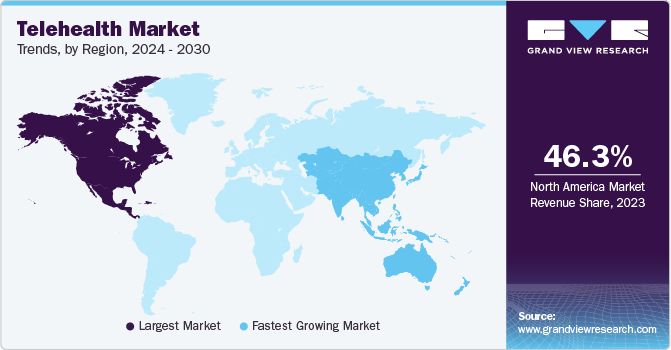
The U.S. held largest market share in North American region owing to advanced healthcare management, innovative software development, and presence of several market players operating across segments, such as mobile & network operations. Reports suggest that around 82% of the population aged between 18 and 49 uses smartphones, through which they can access any available digital health technology. In addition, 15% of population owns a smart wearable device connected to a mobile phone. Growing awareness about available digital health solutions, such as telehealth & mHealth, is driving their adoption rate. Advancements in this industry are improving healthcare accessibility & affordability. Telehealth applications enable monitoring & tracking of information related to chronic diseases and help in managing chronic & post-acute care as well as provide cheaper alternatives for healthcare to growing elderly population.
Asia Pacific is projected to witness the fastest growth during the forecast period. Factors such as the rising geriatric population in countries such as India and Japan, combined with advancements in field of digital health and research initiatives undertaken by the key players in the region are anticipated to contribute to the market growth. Favorable government initiatives to strengthen internet connectivity and growing demand for healthcare and medical assistance in rural regions is expected to positively impact the market growth.
China dominated Asia Pacific market in 2023. The Chinese government actively supports telehealth integration into the healthcare system through policies and initiatives, acting as a crucial driver. With a large and aging population, there's a growing demand for healthcare services, especially in remote areas, making telehealth a convenient solution. Ongoing technological advancements, along with widespread internet access and smartphone usage, create a favorable environment for telehealth expansion. The COVID-19 pandemic has accelerated telehealth adoption, underlining its importance during lockdowns and social distancing. Furthermore, addressing the increasing prevalence of chronic diseases due to urbanization and lifestyle changes, telehealth plays a vital role in offering accessible and convenient healthcare solutions across China.
Key Companies & Market Share Insights
The key players in the market have been involved in mergers and acquisitions to increase their share in the market and provide innovative solutions to the users which is anticipated to boost the market growth during the forecast period. Furthermore, several initiatives are being undertaken by the key players globally, which have significantly contributed to the market growth during COVID-19. Several market players reported exponential growth in revenue during the pandemic as compared to the previous year. For instance, Teladoc Health Inc. reported 63% year-on-year growth in the first two quarters of 2020 as compared to the first two quarters of 2019.
Key Telehealth Companies:
- Koninklijke Philips N.V
- GE Healthcare
- Oracle Cerner (earlier Cerner Corporation)
- Siemens Healthineers
- Medtronic
- Teladoc Health Inc
- American Well
- MDLIVE
- Doctor On Demand
- Global Med
Recent Developments
-
In October 2023 , Glenn Gaunt MD, introduced and official launched alternative to traditional healthcare. The platform offers accessible and convenient healthcare services, enabling patients to receive medical attention from the comfort of their homes
-
In September 2023 , Apollo Telehealth introduced Tele-Emergency ICU services across nine NTPC plants, enhancing critical care capabilities. This initiative aims to provide remote medical supervision and support for emergency situations, leveraging advanced telehealth technologies
-
In August 2023, Amazon announced that it is extending its virtual clinic service, the Amazon Clinic, across the nation. The Amazon Clinic, introduced last November, facilitates patients in connecting with telemedicine providers for the treatment of common conditions such as acne and hair loss
-
In February 2022, Teladoc Health, Inc. launched Chronic Care Complete, a comprehensive solution dedicated to managing chronic conditions. This innovative offering is designed with the primary goal of enhancing healthcare outcomes for individuals grappling with persistent health challenges
-
In February 2022, GlobalMed launched the Portable Audiology Backpack to enable telehealth audiology examinations from a distance, extending the reach of patient care
-
In August 2021, Philips announced launch of Philips Acute Care Telehealth which will provide flexible and configurable solution to help the healthcare systems provide virtual care
Telehealth Market Report Scope
Report Attribute
Details
Market size value in 2024
USD 123.3 billion
Revenue forecast in 2030
USD 455.3 billion
Growth Rate
CAGR of 24.3% from 2023 to 2030
Base year for estimation
2023
Historical data
2018 - 2022
Forecast period
2024 - 2030
Quantitative units
Revenue in USD billion and CAGR from 2024 to 2030
Report coverage
Revenue forecast, company ranking, competitive landscape, growth factors, and trends
Segments covered
Product type, delivery mode, end-use, disease area, region
Regional scope
North America; Europe; Asia Pacific; Latin America; MEA
Country scope
U.S.; Canada; UK; Germany; France; Luxembourg; The Netherlands; Belgium; Italy; Spain; Russia; Japan; China; India; Australia; South Korea; Brazil; Mexico; Argentina; Chile; South Africa; Saudi Arabia; UAE.
Key companies profiled
Koninklijke Philips N.V.; GE Healthcare; Cerner Corporation (Oracle); Siemens Healthineers; Medtronic; Teladoc Health Inc.; American Well; MDLive; Doctor On Demand; Global Med
Customization scope
Free report customization (equivalent up to 8 analysts working days) with purchase. Addition or alteration to country, regional & segment scope.
Pricing and purchase options
Avail customized purchase options to meet your exact research needs. Explore purchase options
Global Telehealth Market Report Segmentation
This report forecasts revenue growth at global, regional, & country levels and provides an analysis of industry trends in each of the sub-segments from 2018 to 2030. For this study, Grand View Research, Inc. has segmented the global telehealth market report based on product type, delivery, end-user, disease area, and region:
-
Product Type Outlook (Revenue, USD Million, 2018 - 2030)
-
Hardware
-
Monitors
-
Medical Peripheral Devices
-
Blood Pressure Meters
-
Blood Glucose Meters
-
Weighing Scales
-
Pulse Oximeters
-
Peak Flow Meters
-
ECG Monitors
-
Others
-
-
-
Software
-
Standalone Software
-
Integrated Software
-
-
Services
-
Remote Patient Monitoring
-
Real-Time Interactions
-
Store and Forward
-
Others
-
-
-
Delivery Mode Outlook (Revenue, USD Million, 2018 - 2030)
-
On-premises
-
Web-based
-
Cloud-based
-
-
End-use Outlook (Revenue, USD Million, 2018 - 2030)
-
Payers
-
Providers
-
Patients
-
-
Disease Area Outlook (Revenue, USD Million, 2018 - 2030)
-
Psychiatry
-
Substance Use
-
Radiology
-
Endocrinology
-
Dermatology
-
Gastroenterology
-
Neurological Medicine
-
ENT
-
Cardiology
-
Oncology
-
Dental
-
Gynecology
-
General Medicine
-
Others
-
-
Regional Outlook (Revenue, USD Million, 2018 - 2030)
-
North America
-
U.S.
-
Canada
-
-
Europe
-
UK
-
Germany
-
France
-
Spain
-
Luxembourg
-
The Netherlands
-
Belgium
-
Italy
-
Russia
-
-
Asia Pacific
-
China
-
Japan
-
India
-
South Korea
-
Australia
-
-
Latin America
-
Brazil
-
Mexico
-
Argentina
-
Chile
-
-
MEA
-
South Africa
-
Saudi Arabia
-
UAE
-
-
Frequently Asked Questions About This Report
b. The global telehealth market size was estimated at USD 101.1 billion in 2023 and is expected to reach USD 123.3 billion in 2024.
b. The global telehealth market is expected to grow at a compound annual growth rate of 24.3% from 2024 to 2030 to reach USD 455.3 billion by 2030.
b. The services segment held the largest share of 47.2% in 2023. The segment is anticipated to grow at a lucrative rate owing to the prevailing trend of outsourcing these services.
b. Some key players operating in the global telehealth market include Teladoc Health, American Well, GE Healthcare, Cerner Corporation, Medtronic, Siemens Healthineers, Koninklijke Philips N.V, Doctor on Demand, and GlobalMed.
b. Key factors that are driving the telehealth market growth include increasing access to basic healthcare along with improved healthcare quality and patient safety by early detection and diagnosis.
Share this report with your colleague or friend.
![gvr icn]()
NEED A CUSTOM REPORT?
We can customize every report - free of charge - including purchasing stand-alone sections or country-level reports, as well as offer affordable discounts for start-ups & universities. Contact us now
![Certified Icon]()
We are GDPR and CCPA compliant! Your transaction & personal information is safe and secure. For more details, please read our privacy policy.
We are committed towards customer satisfaction, and quality service.
"The quality of research they have done for us has been excellent."





